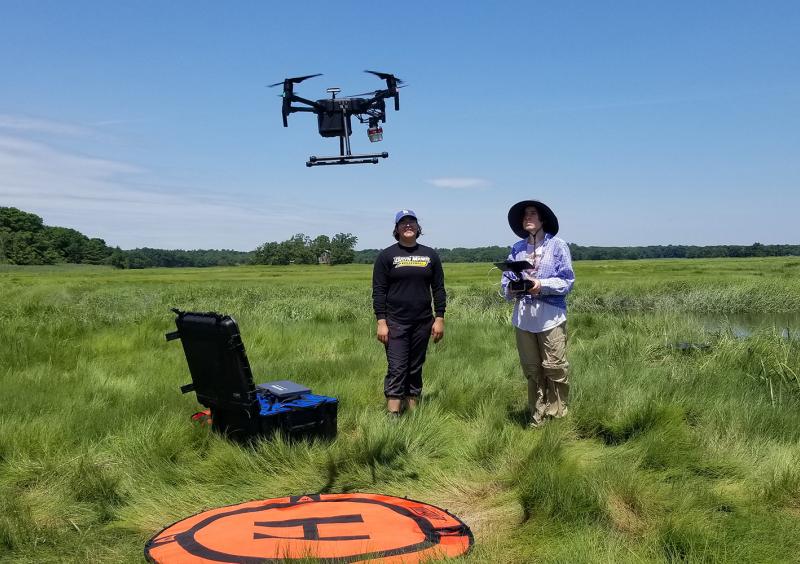
Angela Kaurin '20 and Jocelyn Bravo '22 spent 10 weeks this summer on the coast of northeastern Massachusetts studying the marshlands of the Plum Island sound with Associate Professor of Biology Thomas Mozdzer.
Mozdzer has done research at the Plum Island Ecosystems LTER for the past eight years, providing 15 students the chance to do field work. In collaboration with colleagues at Woods Hole Research Center, The Marine Biological Laboratory, Northeastern University, Virginia Institute of Marine Science (VIMS), the University of Louisiana at Lafayette, and the Smithsonian Environmental Research Center, Mozdzer and previous students had focused on studying the effects of chronic nutrient pollution on salt marshes.
After more than a decade of simulating nutrient pollution, Mozdzer's latest National Science Foundation funded project, which Angela and Jocelyn are taking part in, is studying how salt marsh ecosystems recover from chronic nutrient pollution. This research will inform management and will provide insights on how long it takes for critical ecosystem services to return to reference levels
Angela used two drones to take traditional and thermal images to compare the vegetation patterns of two creeks in the marsh—West, a long-term reference creek, and Sweeny, a long-term nutrient enriched creek. She also worked with the collection of biomass data, which involved harvesting tall and short forms of the grass species Spartina alterniflora as well as Spartina patens and Distichlis spicata.
"After collecting these grasses from quadrats, we dried them in an oven and weighed them," says Angela. "We are trying to see if there are differences in biomass between the creek that was enriched with nitrogen and the control creek. Also, we measured the meters of flowering Spartina alterniflora to see how the timing of the grasses' flowering differed between creeks."
She is currently creating high resolution, multi-spectral maps, that the researchers hope to use to measure plant growth and measure changes in flowering phenology, and working on data entry and analysis for the biomass. The work will serve as the basis for her senior thesis.
Jocelyn also worked with the drones but focused more on the effects of altered food webs on carbon cycling.
"Early this year, our group published a paper indicating that our nutrient enrichment treatments fundamentally changed the structure of the marshes, which also changed the animals that live there," explains Mozdzer.
Jocelyn made special litter bags out of two different types of material that exclude organisms of different sizes, to evaluate if and how changes in animal communities influence decomposition. This project is in collaboration with VIMS Assistant Professor David Johnson, who will be counting and identifying all the invertebrates Jocelyn has collected. Jocelyn continues to work in Professor Mozdzer’s lab processing the bags and analyzing and interpreting the data.
"Having an interest in biology and environmental science has exposed me to different types of fieldwork," says Jocelyn. "However, the summer of 2019 was a whole new experience since I have been given the opportunity to do fieldwork and use the data I collected throughout the semester in an academic setting."
Having grown up in inner-city Los Angeles, Jocelyn says she was a bit unsure what to expect of the marsh but found herself admiring its unique beauty.
"The highlight of my summer was seeing the tall form Spartina alterniflora begin to flower after conducting multiple flowering surveys prior. It was a subtle change at first but as weeks passed my research partner and I began to see the long patches of flowering tall form Spartina alterniflora along the creek banks."
Funding for the students to conduct their research came from Mozdzer's National Science Foundation grant and Bryn Mawr's Summer Science Research Program.
